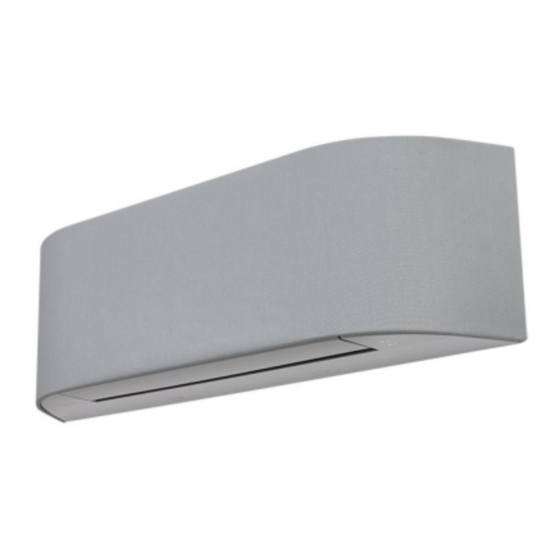
Summarization of Contents
1. SAFETY PRECAUTIONS
General Safety Precautions
Covers precautions for operating and servicing the unit to prevent hazards and ensure safety.
2. SPECIFICATIONS
2-1. Unit Specifications
Details technical specifications including capacity, power, noise, and dimensions for indoor/outdoor units.
2-2. Operation Characteristic Curves
Graphically represents current vs. compressor speed for cooling and heating modes.
2-3. Capacity Variation Ratio According to Temperature
Illustrates how cooling and heating capacity change with outside temperature.
3. REFRIGERANT R32
3-1. Safety During Installation/Servicing
Outlines critical safety measures and precautions when handling R32 refrigerant.
3-2. Refrigerant Piping Installation
Details required piping materials, joints, and processing for R32 refrigerant systems.
3-3. Required Tools
3-3-1. Required Tools List
Lists tools exclusive for R32 and general tools required for installation and servicing.
3-5. Brazing of Pipes
3-5-1. Materials for Brazing
Discusses suitable brazing filler materials for joining copper pipes and alloys.
3-5-2. Flux Requirements
Explains the necessity and types of flux used in brazing for effective metal joining.
4. CONSTRUCTION VIEWS
4-1. Indoor Unit Construction
Illustrates the physical components and dimensions of the indoor unit with a detailed diagram.
4-2. Outdoor Unit Construction
Provides a detailed diagram showing the external views, dimensions, and key parts of the outdoor unit.
6. SPECIFICATIONS OF ELECTRICAL PARTS
6-1. Indoor Unit Electrical Parts
Lists electrical components for the indoor unit with their type names and specifications.
6-2. Outdoor Unit Electrical Parts
Lists electrical components for the outdoor unit with their type names and specifications.
7. REFRIGERANT CYCLE DIAGRAM
7-1. Refrigerant Cycle Diagram
Shows a schematic of the refrigerant flow path for cooling and heating operations.
7-2. Operation Data
Provides operational data for cooling and heating modes under specific temperature conditions.
8. CONTROL BLOCK DIAGRAM
8-1. Indoor Unit Control Block
Illustrates the internal control logic and communication flow for the indoor unit.
8-2. Outdoor Unit Control Block
Details the control system and components within the outdoor unit's inverter assembly.
9. OPERATION DESCRIPTION
9-1. Outline of Air Conditioner Control
Explains the overall control system, roles of indoor/outdoor controllers, and communication signals.
9-2. Operation Description Details
Covers basic, cooling/heating, auto, dry, fan motor, ECO, timer, and other operational modes and functions.
9-3. Auto Restart Function
Explains the auto restart feature, its settings, cancellation, and behavior during power failure.
9-4. Remote control Operations
Details the functions, operations, and display indications of the remote controller.
10. INSTALLATION PROCEDURE
10-1. Installation Diagram
Provides visual guidance on the placement and connection of indoor and outdoor units.
10-2. Installation Parts and Tools
Lists optional installation parts, accessories, and servicing tools required.
10-3. Indoor Unit Installation
Covers installation place, cutting holes, mounting, piping, drain hose, and unit fixing for the indoor unit.
10-4. Outdoor Unit Installation
Details installation place, precautions for snowfall, and refrigerant piping connection for the outdoor unit.
10-5. Electrical Works
Explains wiring, power supply, and connecting cable procedures for both units.
10-6. Other Installation Procedures
Covers gas leak testing, remote control selection, test operation, auto restart setting, and fabric installation.
11. HOW TO DIAGNOSE THE TROUBLE
Inverter and Control Circuit Precautions
Highlights safety precautions for inspecting and handling electronic components and high-voltage circuits.
11-1. First Confirmation Steps
Initial checks for power supply, voltage, and normal operation status before detailed diagnosis.
11-2. Primary Judgment Methods
Outlines methods for initial trouble diagnosis, including LED indicators and remote controller checks.
11-3. Indoor Unit Flashing LED Diagnosis
Explains how to interpret flashing LED patterns on the indoor unit for self-diagnosis codes.
11-4. Remote Controller Self-Diagnosis
Details using the remote controller in service mode to retrieve check codes and diagnose issues.
11-5. Symptom-Based Troubleshooting
Provides troubleshooting flows based on specific symptoms like no power, fan issues, or wiring failures.
11-6. Main Parts Check
Describes procedures to check main components like pulse motor valves and temperature sensors.
11-7. Outdoor Unit Troubleshooting
Covers diagnosis for inverter assembly and outdoor fan motor issues.
11-8. P.C. Board Check
Provides inspection procedures for indoor and outdoor P.C. boards, including sensor checks.
11-9. Outdoor Fan Motor Check
Details how to judge the condition of the outdoor fan motor by checking winding resistance.
12. HOW TO REPLACE THE MAIN PARTS
12-1. Indoor Unit Part Replacement
Step-by-step instructions for removing and replacing key parts of the indoor unit.
12-2. Outdoor Unit Part Replacement
Procedures for disassembling and replacing parts of the outdoor unit, including cabinets and inverter.
13. EXPLODED VIEWS AND PARTS LIST
13-1. Indoor Unit Exploded View
Illustrates the indoor unit's components with a corresponding parts list for easy identification.
13-2. Indoor Unit (Part-E) Exploded View
Shows exploded views and parts list for specific components of the indoor unit (Part-E).
13-3. Outdoor Unit Exploded View
Shows an exploded view of the outdoor unit with a comprehensive list of its parts.
13-4. Outdoor Unit (Part-E) Exploded View
Provides exploded views and parts list for specific components of the outdoor unit (Part-E).
















Need help?
Do you have a question about the RAS-25J2A VSG-ND1 and is the answer not in the manual?
Questions and answers